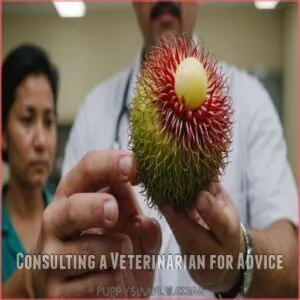This site is supported by our readers. We may earn a commission, at no cost to you, if you purchase through links.

The fleshy part of rambutan is safe and juicy, making it a fun treat, but don’t let your dog gobble the whole fruit!
The skin can pose a choking hazard, and the seed contains saponins, which aren’t dog-friendly.
It’s important to remove these parts before letting your furry friend enjoy.
Always keep an eye out for any signs of an upset stomach or allergic reaction.
Curious about other safe fruity treats? The article will open your eyes to more delicious options for your dog!
Table Of Contents
- Key Takeaways
- What is Rambutan Fruit
- Rambutan Safety for Dogs
- Nutritional Benefits of Rambutan
- Preparing Fresh Rambutan for Healthy Dogs
- Serving Rambutan to Dogs Safely
- Monitoring Your Dog’s Health
- Identifying Rambutan Seeds Poisoning Signs
- Common Health Issues and Risks
- Alternatives to Rambutan Fruit Treats
- Consulting a Veterinarian for Advice
- Frequently Asked Questions (FAQs)
- Can dogs eat rambutan fruit?
- Is rambutan safe for dogs?
- What happens if a dog eats rambutan?
- How much rambutan can a dog eat a day?
- Can you eat rambutan unprepared?
- What does rambutan look like?
- What happens if my dog eats a rambutan seed?
- Which animals eat rambutan?
- Is rambutan fruit safe?
- What kind of fruits dogs Cannot eat?
- Can rambutan interact with dog medications?
- How does rambutan affect diabetic dogs?
- Are there specific breeds more sensitive to rambutan?
- Can dried rambutan be given to dogs?
- How to store rambutan for dog consumption?
- Conclusion
Key Takeaways
- Always remove the skin and seed before giving rambutan to your dog, limiting their intake to the fleshy part only to ensure safety.
- Moderate the quantity to prevent digestive issues, offering rambutan as an occasional treat rather than a dietary staple.
- Keep an eye out for any allergic reactions or signs of digestive discomfort after your dog consumes rambutan.
- It is wise to consult your vet before introducing rambutan, especially if your dog has specific health needs or is taking medications.
What is Rambutan Fruit
You’ve probably seen rambutan at your local market, with its wild, hairy shell and vibrant colors catching your eye.
This tropical fruit, native to Asia, intrigues with its appearance but also finds its way into various dishes with its sweet, grape-like flavor.
Description of Rambutan
Rambutan fruit bursts with personality, showcasing a colorful appearance that catches your eye. Think of a golf ball wrapped in vibrant red skin, dotted with greenish, hair-like spines.
Inside, you’ll find sweet, floral flesh reminiscent of Juicy Fruit gum.
Its structure is unique, making you wonder if it belongs in a fruit bowl or a sci-fi movie.
- Rambutan appearance
- Taste profile
- Fruit structure
Native Origin of Rambutan
Imagine you’re wandering through the vibrant markets of Malaysia and Indonesia, where rambutan has its roots.
This exotic Southeast Asian fruit, with its hairy red or orange exterior, beckons curiosity.
It’s no wonder rambutan’s history is so rich and tropical.
While not a snack for dogs, its intriguing origins spark interest in fruit enthusiasts worldwide.
Uses of Rambutan in Human Food
Planning a culinary venture? You’ll find rambutan fruit in countless recipes around the globe.
Its sweet, juicy flesh adds flair to your meals: To maintain a balanced diet with these recipes and supplement your nutrient intake when needed, understanding effective dietary supplements is key for overall health.
Rambutan desserts bring joy to your taste buds.
Spice up fresh fruit salads with vibrant colors. Pour into tropical cocktails for a lively zing.
Experiment in savory dishes within Asian cuisine.
Can dogs eat rambutan safely? Let’s explore snacks together.
Rambutan Safety for Dogs
Regarding rambutan and your furry friend, you should be cautious since the fruit’s flesh is safe in small amounts, but the skin and seeds can pose significant risks.
It’s important to watch for any signs of allergic reactions, ensuring they enjoy this tropical treat safely.
Risks of Seeds and Skin
Regarding feeding your dog rambutan, watch out for the seeds and skin.
They pose distinct risks, from choking hazards to potential toxicity.
Seeds are notorious for blockages, while the skin might upset your furry friend’s stomach.
Always opt for safe handling—remove seeds, peel the skin, and slice the flesh into small, manageable pieces.
Signs of Allergic Reactions
Having given your dog a rambutan, watch for signs of dog allergies.
Keep an eye out for skin rashes, itching, or swelling.
Vomiting or diarrhea could also indicate a reaction.
These are common dog reactions to new foods, including this exotic dog fruit.
If you see any of these symptoms, contact your vet immediately.
Early intervention is key!
Nutritional Benefits of Rambutan
When considering giving your dog rambutan, you’re offering a fruit rich in vitamins and minerals that can enhance their diet in small amounts.
This tropical treat provides fiber and antioxidants, which support digestion and overall health.
But remember to remove the rind and seeds.
Energy Potential Per Given Meal Unit
With rambutan safely prepped for your dog, let’s talk energy potential.
This tropical treat boasts a mix of nutrients that could add a pep to their step.
Consider these benefits:
- Calorie content is moderate, ideal for active dogs.
- Sugar impact is minimal, preventing sugar spikes.
- Nutritional value supports overall health.
- Treat frequency can complement a balanced canine diet.
Fibrous Strength With Migrative Body Factor Response
Imagine your dog’s gut as a ticking clock, finely tuned by dietary fiber.
Rambutan’s fiber benefits shine as it aids dog digestion, supporting gut health and movement.
While fiber content is high, the skin isn’t suitable for canine health.
Can dogs eat rambutan safely? Yes, but only the flesh, as other fruits like cherries pose serious health risks due to cyanide poisoning risks ensuring your dog food choices reduce health risks.
Preparing Fresh Rambutan for Healthy Dogs
When you’re preparing rambutan for your dog, start by selecting ripe fruit, which is typically vibrant red or orange.
Then wash it thoroughly to remove any pesticides.
Carefully peel the skin and remove the seed, ensuring only the sweet flesh is served as a safe and occasional treat for your furry friend.
Rambutan Fruit Ripe Selection Factors
To pick the best rambutan for your dog, focus on color, texture, and firmness.
Look for fruits with a vibrant red hue, slightly firm texture, and an intact stem.
Smell is another clue; a sweet, fruity aroma signals ripeness.
These factors indicate that the rambutan is tasty for humans but also safe and healthy for dogs eating rambutan, much like bananas which provide potassium, fiber, and antioxidants for dogs in moderation see banana nutritional benefits.
Washing Process & Correct Use Washing Materials
Once you’ve picked the ripest rambutans, wash them carefully.
Use lukewarm water and a dab of safe detergent designed for fruits.
This will help remove any harmful residues.
Be sure to rinse thoroughly, leaving the fruit clean but not soggy.
Drying techniques matter too; pat them gently with a towel.
This washing process will help guarantee fresh fruit for dogs, but it will also make sure the fruit is safe for them to eat.
Seed Removal & Safety Factors After Peel
Now that your rambutan’s clean, carefully peel it open.
The seed’s the problem; it’s toxic and a choking hazard.
Use a spoon to scoop out the delicious, white flesh, avoiding the seed completely.
Remember, a little goes a long way—a small piece is plenty.
Watch your pup for any funny business afterward.
Dog owners, remember, safety first!
Serving Rambutan to Dogs Safely
When serving rambutan to your dog, make sure to use only the flesh.
Limit the amount to prevent digestive issues.
By adjusting the quantity, you can provide a tasty treat that supports your dog’s digestion without the risk of overconsumption.
Providing Rambutan to Use at Safe Quantity
Imagine your dog eagerly waiting for a rambutan snack.
Before giving them a new treat, make sure it’s not as unhealthy as foods high in sodium and MSG.
Start with a piece that mirrors the size of a small berry, taking into account your dog’s weight.
Offer it no more than twice a week.
Keep rambutan a fun treat, not a dietary staple.
Watch their response; remember, moderation prevents tummy troubles and ensures a safe, delightful treat experience!
Maximizing Potential Benefit for Digestive With Quantity Adjust
To boost your dog’s digestive health with rambutan, consider these simple steps.
First, 1. start with a small rambutan dosage, adjusting based on your dog’s weight.
2. Check the treat frequency, offering it sparingly.
3. Enjoy fiber benefits to combat constipation.
4. Appreciate its vitamins and potassium, which support overall health.
Remember, moderation is key to maximizing benefits without overdoing it.
Monitoring Your Dog’s Health
When introducing rambutan to your dog’s diet, it’s vital to monitor their health closely to detect any digestive issues or allergic reactions.
Keep an eye out for symptoms like vomiting, diarrhea, or unusual behavior, and consult a veterinarian if you notice anything amiss.
Digestive System Monitoring Effectiveness
Keeping an eye on your dog’s digestive system starts with noting any changes in stool consistency, digestion time, or appetite.
If you suspect a rambutan allergy, research and consult products for dog rambutan allergy.
Catch early signs, like gas or bloating, and you’ll have a better grasp of their overall health.
Rambutan’s fiber can help, but observe how it affects digestion, especially in puppies and sensitive breeds like Shih Tzus.
Allergic Reaction Symptoms Detection
Spotting an allergic reaction in your dog starts with a keen eye.
Watch for rambutan allergy signs like skin rash, vomiting, or diarrhea.
Breathing issues can also occur and require immediate attention.
Different dog breeds may react differently, especially if they’re prone to dog obesity or diabetes.
Consult your vet for personalized advice, ensuring your furry friend’s safety.
Identifying Rambutan Seeds Poisoning Signs
Knowing the signs of rambutan seed poisoning in your dog is important for their safety.
If you suspect your dog has ingested rambutan seeds, watch for vomiting, diarrhea, lethargy, or loss of appetite.
Contact your veterinarian immediately for guidance.
Treatment for Seed Ingested Blockage
Pay close attention if your dog swallows a rambutan seed.
Signs like vomiting, a swollen tummy, or refusing food should set off alarms.
Don’t wait for digestive chaos; treat it like a puzzle needing quick solving.
Avoid inducing vomiting at home, as it may cause more harm.
An emergency vet might recommend an X-ray or possibly surgery for blockage removal.
Emergency Veterinary Contact
If your dog swallows a rambutan seed, watch for poisoning signs like vomiting or unusual behavior.
An emergency veterinary contact is essential here.
Seeds are a choking hazard and can cause toxicity, so acting quickly is crucial.
A vet visit can prevent severe issues, ensuring your dog’s safety.
When in doubt, consulting a vet is always a good idea.
Do Not Induce Vomiting
Many pet owners may face worrisome situations involving Rambutan Toxicity.
Don’t induce vomiting if your dog ingests rambutan seeds.
Instead, focus on these key symptoms:
- Vomiting
- Diarrhea
- Abdominal Pain
- Lethargy
- Appetite Loss
Seek Vet Advice promptly for Emergency Treatment.
Always consult professionals about Safe Alternatives to protect your pet’s health and well-being.
Common Health Issues and Risks
If you decide to feed your dog rambutan, you need to be aware of potential health issues like intestinal blockages and choking hazards from the seeds and skin.
Additionally, the fruit poses risks of toxicity and allergic reactions, so it’s important to closely monitor your dog when introducing this tropical treat.
Intestinal Blockages and Choking Hazards
Spotting seed poisoning leads us to another pressing issue with Rambutan fruit.
Those golf ball-sized seeds pose a dog choking risk and could cause an intestinal blockage, which can lead to severe constipation if not addressed, as noted in situations where a dog may go without pooping for over 24-36 hours.
It’s important to remove seeds entirely.
Follow these tips for safe preparation:
| Tip | Details |
|---|---|
| Rambutan seed size | Small enough to swallow |
| Seed removal tips | Use a knife to safely extract |
| Blockage prevention | Keep seeds away from dog altogether |
Toxicity and Allergic Reactions
Shifting focus from choking hazards to the hidden concerns of rambutan toxicity, consider the risks of allergic reactions in dogs.
Look for signs like:
- Allergic symptoms: Itchy skin or ears
- Skin reactions: Redness or hives
- Seed poisoning: Watch for vomiting
- Risks involved: Popular myths might mislead
- Monitoring your dog’s health: Seek help if needed
Remember, moderation is key!
Alternatives to Rambutan Fruit Treats
So, you’ve learned about the potential pitfalls of rambutan for your furry friend.
Let’s explore safer, equally delicious alternatives!
Don’t worry, there are plenty of yummy options to keep your dog happy and healthy.
For dogs with food allergies, it’s also a good idea to think about making your own treats using ingredients like novel proteins and grain-free flours found in homemade dog treats for allergies.
Here are some dog-safe fruit options:
- Blueberries – Packed with antioxidants!
- Bananas – A good source of potassium. Just watch the sugar.
- Apples (without the core and seeds) – A crunchy treat.
- Cantaloupe – Hydrating and invigorating.
- Strawberries – Sweet and full of vitamin C.
Remember, moderation is key with any treat.
You can also explore safe fruits like cooked plantains, which are packed with potassium and fiber, or homemade dog snacks or commercial dog treats designed with your pup’s dietary needs in mind.
Always check the ingredient list to make sure they’re safe and healthy.
These healthy alternatives provide a fun and nutritious change of pace.
Enjoy finding your dog’s new favorite treat!
Consulting a Veterinarian for Advice
Before introducing rambutan into your dog’s diet, consulting a veterinarian is very important to get advice based on your dog’s specific health needs and potential allergies.
A vet can also help you navigate other human foods, like nuts, and advise on safe options such as peanuts and hazelnuts. A vet can offer guidance on safe consumption amounts and help make sure rambutan complements rather than complicates your pet’s nutritional plan.
Importance of Professional Guidance
Engaging experts in your dog diet journey is essential. Consulting a vet makes sure your pup’s safety when trying new treats like rambutan. It’s not just about avoiding rambutan risks but understanding nutritional breakdowns and debunking myths. Prioritize professional advice to monitor health impacts or identifying rambutan seed poisoning signs.
For the best nutrition, consider a balanced diet that includes High Protein Natural Kibble.
Keep puppy safety in check!
| Issue | Importance | Action Plan |
|---|---|---|
| Nutritional Breakdown | Dog diet health | Consult your vet |
| Rambutan Risks | Avoid misrepresentation | Get expert clarification |
| Puppy Safety | Delicate digestion | Start with small portions |
| Seed Poisoning Signs | Emergency help | Know the signs and respond |
| Safe Treats | Balance in diet | Professional guidance needed |
Customized Dietary Recommendations
When creating a dog-specific diet, consult your vet for personalized advice. They’ll help navigate potential rambutan allergy risks and puppy rambutan safety.
You can also explore dog rambutan treats online at dog rambutan store. Discuss treat alternatives to keep your furry friend happy.
- Vet consultation for personalized advice
- Nutritional breakdown for canine diets
- Monitoring for rambutan side-effects
- Identifying seed poisoning signs
- Exploring safe treat alternatives
Frequently Asked Questions (FAQs)
Can dogs eat rambutan fruit?
While rambutan’s sweet taste might tempt your pup, sticking to small amounts of flesh only is key.
Avoid the skin and seed, as they pose risks.
Moderation is essential, and consult your vet for advice.
Is rambutan safe for dogs?
Yes, but only the flesh! Keep the skin and seeds away; they’re toxic. Offer small amounts as an occasional treat. Always watch for any tummy troubles.
What happens if a dog eats rambutan?
If your dog eats rambutan, the flesh is safe in small amounts, but the skin and seeds can be harmful.
Monitor for choking or digestive issues, and consult a vet if you notice any adverse reactions.
How much rambutan can a dog eat a day?
Limit your dog’s rambutan intake to a few bites per day.
Peel and remove seeds before feeding.
Monitor for adverse reactions, and remember, rambutan should be an occasional treat, not a regular part of their diet.
Can you eat rambutan unprepared?
Eating rambutan without preparation isn’t wise.
The hairy skin is tough and inedible, and the seed inside can be bitter.
Peel the skin, remove the seed, and enjoy the sweet flesh for a tasty tropical treat.
What does rambutan look like?
Rambutan might remind you of a hairy golf ball, sporting spiky red, orange, or yellow skin.
Inside, the juicy, white flesh offers a sweet, floral taste, like Juicy Fruit gum, similar to lychee and longan.
What happens if my dog eats a rambutan seed?
If your dog eats a rambutan seed, it could cause a choking hazard or intestinal blockage.
Also, the seed is toxic, so contact your vet immediately to guarantee your pet’s safety and avoid potential complications.
Which animals eat rambutan?
Imagine wandering through a tropical fruit orchard, and you notice monkeys delightfully munching on rambutan fruits.
Birds and other small mammals happily join in this feast, savoring the sweet, juicy flesh hidden beneath the fruit’s hairy exterior.
Is rambutan fruit safe?
The rambutan’s sweet flesh is generally safe, but you must remove the skin and seed. These parts aren’t safe for consumption and can cause problems. Enjoy in moderation!
What kind of fruits dogs Cannot eat?
Grapes, raisins, avocados, cherries, and citrus fruits can harm dogs.
Grapes and raisins can cause kidney damage.
Avocados contain persin.
Cherries have cyanide in pits.
Citrus fruits might upset their stomachs.
Always consult your vet.
Can rambutan interact with dog medications?
There’s limited information on rambutan interacting with dog medications.
However, as a precaution, consult your vet before introducing rambutan, especially if your dog is on medication, to avoid potential complications or adverse effects.
Stay cautious!
How does rambutan affect diabetic dogs?
Feeding rambutan to diabetic dogs isn’t advisable due to its high sugar content, which can spike blood sugar levels, leading to health complications.
Consult your veterinarian for dietary advice specific to your diabetic dog’s needs.
Are there specific breeds more sensitive to rambutan?
While no specific dog breeds are particularly sensitive to rambutan, individual reactions vary.
Always introduce rambutan slowly, watching for allergic reactions or digestive issues.
Consult your vet for guidance, especially if your dog has digestive sensitivities.
Can dried rambutan be given to dogs?
When considering dried rambutan for your furry friend, it’s best to think twice.
The drying process concentrates sugars, which can lead to blood sugar spikes.
Plus, the skin and seeds remain toxic and should be avoided entirely.
How to store rambutan for dog consumption?
Store rambutan in the fridge in a breathable bag to keep it fresh.
Before serving, wash thoroughly, peel, and remove seeds.
Offer only a small amount; treat rambutan as a special, occasional snack for your dog.
Conclusion
Think of your dog’s tummy as a delicate garden; you wouldn’t plant just anything there!
So, can dogs eat rambutan? Yes, but with caution.
Remember, only offer the fleshy part, carefully removing the skin and seed. Those contain saponins, which aren’t good for your pup.
Small amounts of rambutan can be a tasty treat, but always monitor your dog for any digestive upset.
A little goes a long way!
If you’re unsure, always chat with your vet; they’re the best gardeners for your furry friend’s health.
















